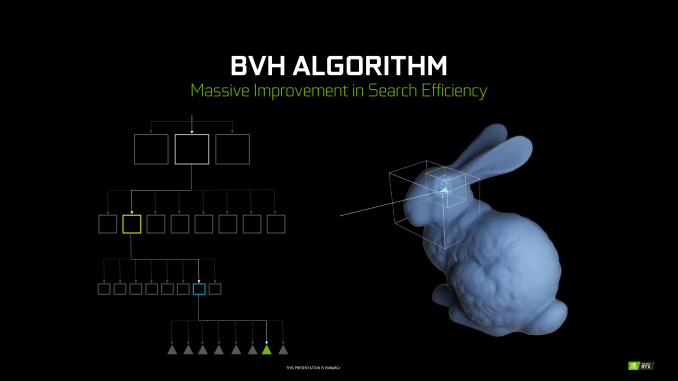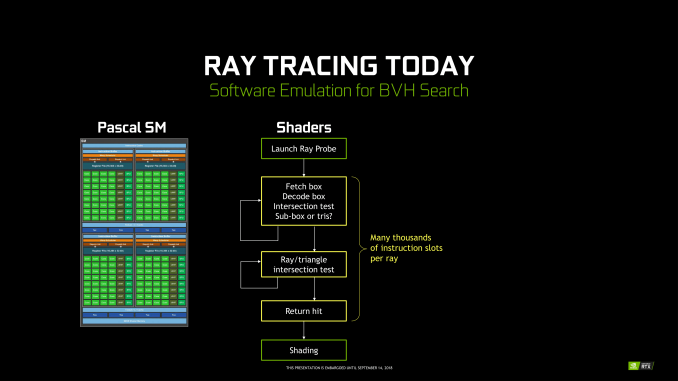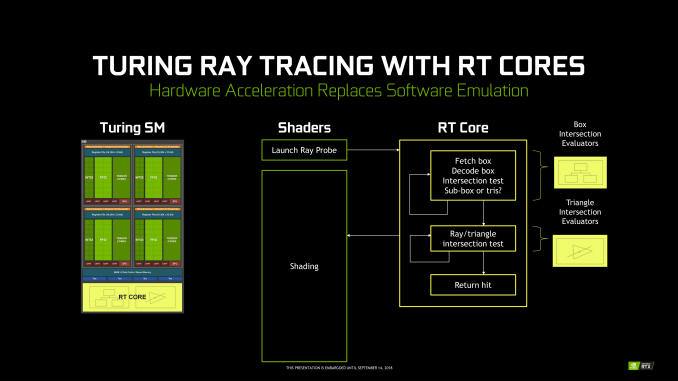The NVIDIA Turing GPU Architecture Deep Dive: Prelude to GeForce RTX
by Nate Oh on September 14, 2018 12:30 PM ESTTuring RT Cores: Hybrid Rendering and Real Time Raytracing
As it presents itself in Turing, real-time raytracing doesn’t completely replace traditional rasterization-based rendering, instead existing as part of Turing’s ‘hybrid rendering’ model. In other words, rasterization is used for most rendering, while ray-tracing techniques are used for select graphical effects. Meanwhile, the ‘real-time’ performance is generally achieved with a very small amount of rays (e.g. 1 or 2) per pixel, and a very large amount of denoising.
The specific implementation is ultimately in the hands of developers, and NVIDIA naturally has their raytracing development ecosystem, which we’ll go over in a later section. But because of the computational intensity, it simply isn’t possible to use real-time raytracing for the complete rendering workload. And higher resolutions, more complex scenes, and numerous graphical effects also compound the difficulty. So for performance reasons, developers will be utilizing raytracing in a deliberate and targeted manner for specific effects, such as global illumination, ambient occlusion, realistic shadows, reflections, and refractions. Likewise, raytracing may be limited to specific objects in a scene, and rasterization and z-buffering may replace primary ray casting while only secondary rays are raytraced. Thus, the goal of developers is to use raytracing for the most noticeable and realistic effects that rasterization cannot accomplish.
Essentially, this style of ‘hybrid rendering’ is a lot less raytracing than one might imagine from the marketing material. Perhaps a blunt way to generalize might be: real time raytracing in Turing typically means only certain objects are being rendered with certain raytraced graphical effects, using a minimal amount of rays per pixel and/or only raytracing secondary rays, and using a lot of denoising filtering; anything more would affect performance too much. Interestingly, explaining all the caveats this way both undersells and oversells the technology, because therein lies the paradox. Even in this very circumscribed way, GPU performance is significantly affected, but image quality is enhanced with a realism that cannot be provided by a higher resolution or better anti-aliasing. Except ‘real time’ interactivity in gaming essentially means a minimum of 30 to 45 fps, and lowering the render resolution to achieve those framerates hurts image quality. What complicates this is that real time raytracing is indeed considered the ‘holy grail’ of computer graphics, and so managing the feat at all is a big deal, but there are equally valid professional and consumer perspectives on how that translates into a compelling product.
On that note, then, NVIDIA accomplished what the industry was not expecting to be possible for at least a few more years, and certainly not at this scale and development ecosystem. Real time raytracing is the culmination of a decade or so of work, and the Turing RT Cores are the lynchpin. But in building up to it, NVIDIA summarizes the achievement as a result of:
- Hybrid rendering pipeline
- Efficient denoising algorithms
- Efficient BVH algorithms
By themselves, these developments were unable to improve raytracing efficiency, but set the stage for RT Cores. By virtue of raytracing’s importance in the world of computer graphics, NVIDIA Research has been looking into various BVH implementations for quite some time, as well as exploring architectural concerns for raytracing acceleration, something easily noted from their patents and publications. Likewise with denoising, though the latest trend has veered towards using AI and by extension Tensor Cores. When BVH became a standard of sorts, NVIDIA was able to design a corresponding fixed function hardware accelerator.
Being so crucial to their achievement, NVIDIA is not disclosing many details about the RT Cores or their BVH implementation. Of the details given, much is somewhat generic. To reiterate, BVH is a rather general category, and all modern raytracing acceleration structures are typically BVH or kd-tree based.
Unlike Tensor Cores, which are better seen as an FMA array alongside the FP and INT cores, the RT Cores are more like a classic offloading IP block. Treated very similar to texture units by the sub-cores, instructions bound for RT Cores are routed out of sub-cores, which is later notified on completion. Upon receiving a ray probe from the SM, the RT Core proceeds to autonomously traverse the BVH and perform ray-intersection tests. This type of ‘traversal and intersection’ fixed function raytracing accelerator is a well-known concept and has had quite a few implementations over the years, as traversal and intersection testing are two of the most computationally intensive tasks involved. In comparison, traversing the BVH in shaders would require thousands of instruction slots per ray cast, all for testing against bounding box intersections in the BVH.
Returning to the RT Core, it will then return any hits and letting shaders do implement the result. The RT Core also handles some grouping and scheduling of memory operations for maximizing memory throughput across multiple rays. And given the workload, presumably some amount of memory and/or ray buffer within the SIP block as well. Like in many other workloads, memory bandwidth is a common bottleneck in raytracing, and has been the focus of several NVIDIA Research papers. And in general, raytracing workloads result in very irregular and random memory accesses, mainly due to incoherent rays, that prove especially problematic for how GPUs typically utilize their memory.
But otherwise, everything else is at a high level governed by the API (i.e. DXR) and the application; construction and update of the BVH is done on CUDA cores, governed by the particular IHV – in this case, NVIDIA – in their DXR implementation.
All-in-all, there’s clearly more involved, and we’ll be looking to run some microbenchmarks in the future. NVIDIA’s custom BVH algorithms are clearly in play, but right now we can’t say what the optimizations might be, such as compressions, wide BVH, node subdivision into treelets. The way the RT Cores are integrated into the SM and into the architecture is likely crucial to how it operates well. Internally, the RT Core might just be a basic traversal and intersection unit, but it might also have other bits inside; one of NVIDIA’s recent patents provide a representation, albeit dated, of what else might be present. I, for one, would not be surprised to see it closely tied with the MIO blocks, and perhaps did more with coherency gathering by manipulating memory traffic for higher efficiency. It would need to coordinate well with the other workloads in the SMs without strangling memory access with unmitigated incoherent rays.
Nevertheless, details like performance impact are as yet unspecified.













111 Comments
View All Comments
BurntMyBacon - Monday, September 17, 2018 - link
Good article. I would have been nice to get more information as to exactly what nVidia is doing with the RT cores to optimize ray tracing, but I can understand why they would want to keep that a secret at this point. One oversight in an otherwise excellent article:@Nate Oh (article): "The net result is that with nearly every generation, the amount of memory bandwidth available per FLOP, per texture lookup, and per pixel blend has continued to drop. ... Turing, in turn, is a bit of an interesting swerve in this pattern thanks to its heavy focus on ray tracing and neural network inferencing. If we're looking at memory bandwidth merely per CUDA core FLOP, then bandwidth per FLOP has actually gone up, since RTX 2080 doesn't deliver a significant increase in (on-paper) CUDA core throughput relative to GTX 1080."
The trend has certainly been downward, but I was curious as to why the GTX 780 wasn't listed. When I checked it out, I found that it is another "swerve" in the pattern similar to the RTX2080. The specifications for the NVIDIA Memory Bandwidth per FLOP (In Bits) chart are:
GTX 780 - 0.58 bits | 3.977 TFLOPS | 288GB/sec
This is easily found information and its omission is pretty noticeable (at least to me), so I assume it got overlooked (easy to do in an article this large). While it doesn't match your initial always downward observation, it also clearly doesn't change the trend. It just means the trend is not strictly monotonic.
nboelter - Tuesday, September 18, 2018 - link
I had to solve the problem of “random memory accesses from the graphics card memory are the main bottleneck for the performance of the molecular dynamics simulation” when i did some physics on CUDA, and got great results with Hilbert space-filling curves (there is a fabulous german paper from 1891 about this newfangled technology) to - essentially - construct BVHs. Only difference really is that i had grains of sand instead of photons. Now i really wonder if these RT cores could be used for physics simulations!webdoctors - Tuesday, September 18, 2018 - link
This will likely get lost in the 100 comments, but this is really huge and getting ignored by the pricing.I've often wondered and complained for years to my friends why we keep going to higher resolutions from 720p to 4K rather than actually improving the graphics. Look at a movie on DVD from 20 yrs ago at 480p resolution, and the graphics are so much more REALISTSIC than the 4K stuff you see in games today because its either real ppl on film or if CG raytraced offline with full lighting. Imagine getting REAL TIME renders that look like real life video, that's a huge breakthrough. Sure we've raytracing for decades, but never real time on non-datacenter size clusters.
Rasterization 4K or 8K content will never look as REAL as 1080p raytraced content. It might look nicer, but it won't look REAL. Its great we'll have hardware where we can choose whether we want to use the fake rasterization cartoony path or the REAL path.
A 2080TI that costs $1200 will be $120 in 10 years, but it won't change the fact that now you're getting REAL vs fake. 2 years ago, you didn't have the option, you couldn't say I'll pay you $5k to give me the ray traced option in the game, now we'll get (hopefully) developer support and see this mainstream. Probably can use AWS to gamestream this instead of buying a video card and than get the raytrace now too.
If you're happy with non-ray tracing, just buy a 1070 and stick to playing games in 1080p. You'll never be perf limited for any games and move on.
eddman - Wednesday, September 19, 2018 - link
You are not getting REAL with 20 series, not even close.MadManMark - Wednesday, September 19, 2018 - link
His point is that we are getting CLOSER to "real," not that it is CLOSE or IS real. Would have thought that was obvious, but guess ti isn't to everyone.eddman - Thursday, September 20, 2018 - link
It seems you are the one who misread. From his comment: "it won't change the fact that now you're getting REAL vs fake"So, yes, he does think with 20 series you get the REAL thing.
sudz - Wednesday, September 19, 2018 - link
"as opposed Pascal’s 2 partition setup with two dispatch ports per sub-core warp scheduler."So in conclusion: RTX has more warp cores.
Engage!
ajp_anton - Friday, September 21, 2018 - link
This comment is a bit late, but your math for memory efficiency is wrong.If bandwidth+compression gives a 50% increase, and bandwidth alone is a 27% increase, you can't just subtract them to get the compression increase. In this example, compression increase is 1.5/1.27 = 1,18, or 18%. Not the 23% that you get by subtracting.
This also means you have to re-write the text where you think it's weird how this is higher than the last generation increase, because it no longer is higher.
Overmind - Thursday, September 27, 2018 - link
There are many inconsistencies in the article.Overmind - Thursday, September 27, 2018 - link
If the 102 with 12 complete functional modules has 72 RTCs (RTX-ops) how can the 2080 Ti with 11 functional modules has 78 RTCs ? The correct value is clearly 68.